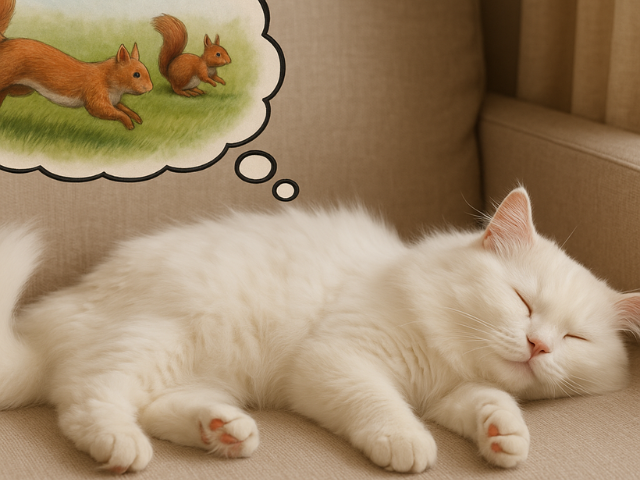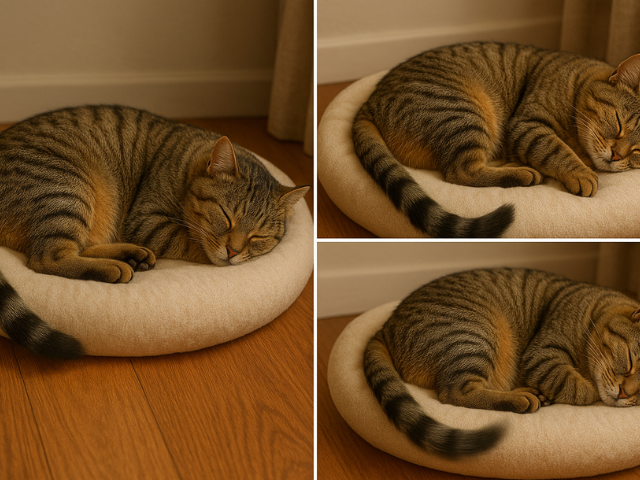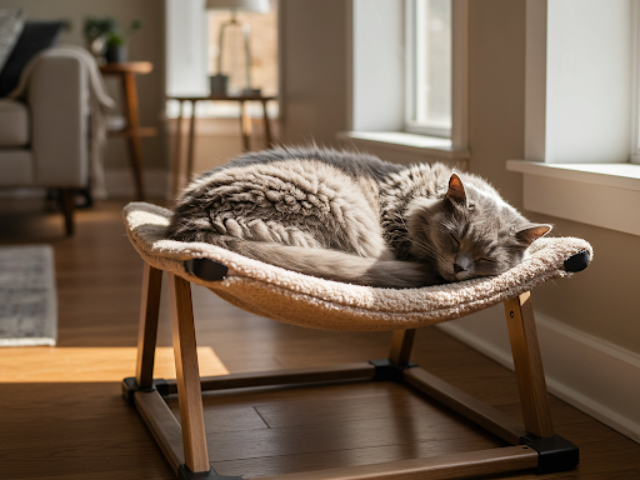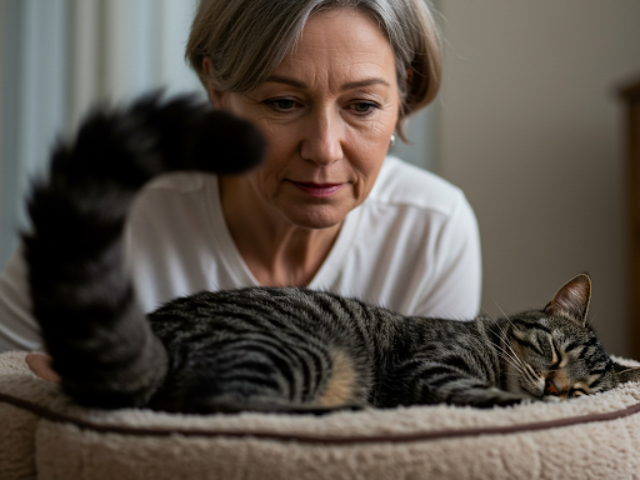You love watching your cat sleep. They curl up all snug and cozy, looking super peaceful and blissfully lost in dreamland. Then you catch a little movement—a quick flick, a gentle swish, or even a solid thump from their tail. It makes you pause and wonder, “Why do cats wag their tails while sleeping?” Are they uneasy, or are they dreaming?
Let’s find out the fascinating reasons behind this behavior you see in your sleeping feline friend.

Cats are champion nappers, often sleeping 12 to 16 hours daily—sometimes even more! Their sleep happens in cycles, much like ours.
Cats go through different stages of sleep. At first, they might fall into a light sleep. You might notice they’re still alert to sounds and movements around them. Their ears might twitch, or they might shift positions rapidly. This stage is sometimes called “catnapping.” During this phase, they can wake up quickly if needed.
Then, they can move into a deeper sleep. It’s where the real rest and restoration happen. Rapid eye movement, or REM, is a key part of deep sleep. If you look at your cat while it’s sleeping during REM, you might see its eyes moving under its lids. This phase is also when dreams come up.
The amount of sleep a cat needs can change as they get older. Kittens can sleep for almost the whole day to grow. Adult cats usually settle into that 12-16 hour range. Senior cats often start sleeping more again as they age.
Their innate instincts as predators also play a role. Wild cats should save their energy for hunting. Even though your house cat might only hunt toy mice, those instincts are still there, leading to lots of naps.

Cats dream just like we do. During REM sleep, their brains replay experiences, which can cause involuntary muscle movements. Tail wagging while sleeping is often one of these involuntary twitches, acting out parts of their dream.
What might your cat be dreaming about? It could be chasing a favorite toy, stalking imaginary prey, or enjoying a gentle petting session. These dream scenarios trigger muscle activity, including tail flicks or twitches. The tail’s movement is a natural response to their dreams.
These dream-related tail movements are natural and show that your cat is experiencing healthy, restful sleep. Seeing those tiny tail flicks can be a charming glimpse into your cat’s dream.
But dreaming isn’t the only culprit. Here’s why cats flick their tails while snoozing.
Outside of dreaming, cats’ muscles can twitch while asleep. These twitches are part of brain activity and help maintain muscle tone and coordination. You might see your cat’s whiskers, paws, or tail twitch gently as their nervous system stays active.
The tail is especially noticeable because it has many muscles and is key for communication and balance. Slight twitches or flicks of the tail during sleep are usually harmless and a sign of your cat’s body staying responsive.
If you watch closely, you’ll see that these movements vary in speed and intensity, reflecting different sleep stages and brain activity.
Sometimes, your cat’s tail moves simply because they change their position to get more comfortable. Cats often curl and stretch to find the perfect sleeping situation. A slight flick or swish can help your furball settle comfortably without fully waking up. This subtle movement is part of how cats keep themselves cozy during rest.
Cats have incredibly sharp senses, even while asleep. A noise like your voice, another pet moving nearby, or a door closing might cause a semi-conscious reaction. Their tail may twitch or flick lightly as they respond without fully waking. It’s how they acknowledge their surroundings while still resting.

Not every tail movement means the same thing. You might notice a few different styles of sleepy tail action:
Generally, there is no reason to be concerned if your cat’s tail moves slowly. A sudden or sharp movement might mean they’re reacting to something more intense, but it is not necessarily a problem.

Seeing your cat’s tail moving or twitching while asleep is normal. In most cases, these gentle movements are harmless and a natural part of your feline friend’s sleep cycle. However, there are a few rare situations where you might need to keep an eye on them.
If you notice aggressive or erratic thrashing movements or your cat seems distressed, showing signs of confusion or disorientation upon waking, the best course of action is always to talk to your veterinarian. They can provide expert advice and rule out any underlying health issues.
Then again, those sleepy tail wags are just a charming part of your cat’s normal resting state. Always watch for any drastic changes in behavior, but relish in the whimsical nature of your cat’s dreamy antics!

Understanding why cats wag their tail while sleeping and when to ask for a vet’s advice is crucial, but giving them well-deserved sleep is also key. There are several simple things you can do to help your furry friend get the peaceful slumber they need.
Cats often have a few favorite spots. You can help by making these spots extra inviting to catch Zs.
Avoid waking your cat suddenly, especially if they are in a deep sleep. While moving your kitty gently is okay, loud noises or abrupt awakenings can be startling and stressful for them. If you have children, teach them to respect the cat’s sleep time. A cat that feels secure and undisturbed while asleep will likely get quality rest.
If your household is often busy or noisy, try to ensure your cat has a dedicated quiet retreat where they can escape the commotion and get some uninterrupted sleep. Giving them a dedicated resting spot helps them feel more secure and can improve their overall well-being.
Getting enough sleep promotes your cat’s physical and mental health. During sleep, their bodies repair tissues, conserve energy, and consolidate memories.
A lack of good sleep can lead to a weaker immune system, irritability, and stress. Providing your furry friend with a peaceful and restful sleep environment helps contribute to their overall happiness and well-being, as well as a longer life. Knowing why cats wag their tail while sleeping is one part of being a great cat parent; ensuring they have good sleep is another.

As we’ve discovered, there isn’t just one single answer. Usually, that adorable sleepy tail movement indicates dreaming, involuntary muscle twitching, comfort adjustments, or subtle reactions to their environment. These tail movements are a normal, natural part of how cats rest and dream. Watching your cat’s tail flick or twitch can be a charming glimpse into their dreams, showing how alive their minds are even when asleep.
These small movements remind us that cats are complex creatures with rich dream lives and sensitive senses. They adjust their bodies to stay comfortable and keep an eye on their surroundings, even in deep sleep. Understanding why cats wag their tails while sleeping helps you appreciate the quiet moments you share with your feline friend.
So next time you see your cat’s tail twitch during a nap, you can smile knowing it’s a sign of healthy sleep and maybe a little adventure in dreamland. These little mysteries are part of what makes living with cats so rewarding and full of wonder.

